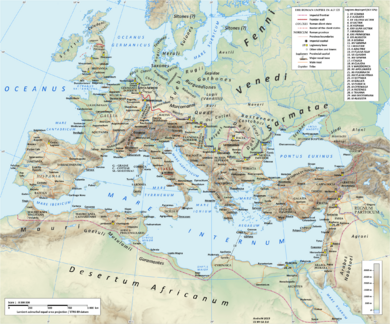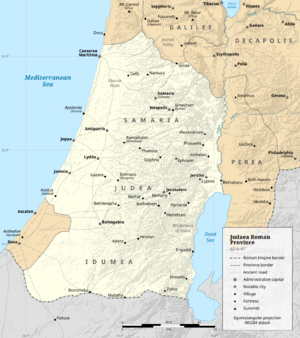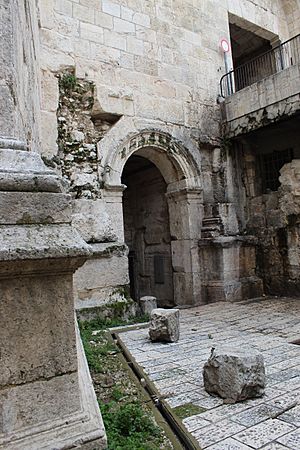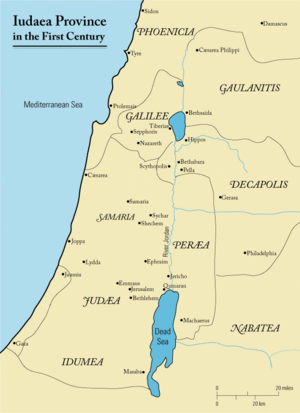Judaea (Roman province) facts for kids
Quick facts for kids Province of Judaea
|
|||||||||
|---|---|---|---|---|---|---|---|---|---|
| Province of the Roman Empire | |||||||||
| 6–132 AD | |||||||||
 The Roman Empire under the reign of Hadrian (125 AD) with Judaea highlighted in red |
|||||||||
| Capital | Caesarea Maritima | ||||||||
| Area | |||||||||
| • Coordinates | 32°30′N 34°54′E / 32.500°N 34.900°E | ||||||||
| Government | |||||||||
| Prefects before 41, Procurators after 44 | |||||||||
|
• 6–9 AD
|
Coponius | ||||||||
|
• 26–36 AD
|
Pontius Pilate | ||||||||
|
• 64–66 AD
|
Gessius Florus | ||||||||
|
• 117 AD
|
Lusius Quietus | ||||||||
|
• 130–132 AD
|
Tineius Rufus | ||||||||
| King of the Jews | |||||||||
|
• 41–44
|
Agrippa I | ||||||||
|
• 48–93/100
|
Agrippa II | ||||||||
| Legislature | Synedrion/Sanhedrin | ||||||||
| Historical era | Roman Principate | ||||||||
| 6 | |||||||||
| c. 30/33 AD | |||||||||
|
• Crisis under Caligula
|
37–41 AD | ||||||||
|
• Incorporation of Galilee and Peraea
|
44 AD | ||||||||
|
• Destruction of the Second Temple
|
70 AD | ||||||||
|
• Governor of praetorian rank and given the 10th Legion
|
c. 74 AD | ||||||||
|
• Merging into Syria Palestina
|
132 AD 132 AD | ||||||||
|
|||||||||
| Today part of | Israel Palestine |
||||||||
| Before 4 August 70 is referred to as Second Temple Judaism, from which the Tannaim and Early Christianity emerged. | |||||||||
Judaea (Latin: Iudaea [juːˈdae̯.a]; Ancient Greek: Ἰουδαία, romanized: Ioudaía [i.uˈdɛ.a]) was a Roman province from 6 to 132 AD, which incorporated the Levantine regions of Idumea , Philistia , Judea, Samaria and Galilee, extending over parts of the former regions of the Hasmonean and Herodian kingdoms of Judea. The name Judaea (like the similar Judea) was derived from the Iron Age Kingdom of Judah , that was centered predominantly in Judea.
Since the Roman Republic's conquest of Judea in 63 BC, the latter had maintained a system of semi-autonomous vassalage. The incorporation of the Roman province was enacted by the first Roman emperor, Augustus, after an appeal by the populace against the ill rule of Herod Archelaus (4 BC – 6 AD).
With the onset of direct rule, the official census instituted by Publius Sulpicius Quirinius, the governor of Roman Syria, caused tensions and led to an uprising by Jewish rebel Judas of Galilee (6 AD). Other notable events in the region include the crucifixion of Jesus c. 30–33 AD (which led to the emergence of Christianity) and in 37 AD, Emperor Caligula ordered the erection of a statue of himself in the Jewish temple.
Growing discontent at Roman rule led to the First Jewish–Roman War in 66–73 AD and ultimately the Siege of Jerusalem and destruction of the temple in 70 AD, bringing an end to the Second Temple period. In 44 AD, Galilee and Perea were added to the province. In 132 AD, sources say the merging of Galilee and Judea resulted in an enlarged province named Syria Palaestina.
Contents
Background
The first intervention of Rome in the region dates from 63 BCE, following the end of the Third Mithridatic War, in which Pompey defeated Mithridates VI Eupator, sacked Jerusalem, and established the province of Syria. The assertion of Roman hegemony and the rise of Roman political and cultural influence brought an end to Hellenistic Judea.
Pompey installed the Hasmonean prince Hyrcanus II as Ethnarch and High Priest of Israel, but not as king. Some years later Julius Caesar appointed Antipater the Idumaean, also known as Antipas, as the first Roman Procurator. Antipater's son Herod was designated "King of the Jews" by the Roman Senate in 40 BCE but he did not gain military control until 37 BCE. During his reign, the last representatives of the Hasmoneans were eliminated, and the huge port of Caesarea Maritima was built.
Herod died in 4 BCE, and his kingdom was divided among three of his sons, two of whom (Philip and Herod Antipas) became tetrarchs ('rulers of a quarter part'). The third son, Archelaus, became an ethnarch and ruled over half of his father's kingdom. One of these principalities was Judea, corresponding to the territory of the historic Judea, plus Samaria and Idumea.
Archelaus ruled Judea so badly that he was dismissed in 6 CE by the first Roman emperor, Augustus, after an appeal from his own population. Herod Antipas, ruler of Galilee and Perea from 4 BCE, was dismissed by Emperor Caligula in 39 CE. Herod's son Philip ruled the northeastern part of his father's kingdom.
Judea as a Roman province

Revolt and removal of Herod Archelaus
Following the death of Herod the Great, the Herodian Kingdom of Judea was divided into the Herodian Tetrarchy, jointly ruled by Herod's sons and sister: Herod Archelaus (who ruled Judea, Samaria and Idumea), Herod Philip (who ruled Batanea, Trachonitis as well as Auranitis), Herod Antipas (who ruled Galilee and Perea) and Salome I (who briefly ruled Jamnia).
A messianic revolt erupted in Judea in 4 BCE because of Archelaus's incompetence; the revolt was brutally crushed by the Legate of Syria, Publius Quinctilius Varus, who occupied Jerusalem and crucified 2,000 Jewish rebels.
Because of his failure to properly rule Judea, Archelaus was removed from his post by Emperor Augustus in 6 CE, while Judea, Samaria, and Idumea came under direct Roman administration.
This event had significant and ever-lasting effects on the Jewish population, the Temple, and the development of Christianity.
Under a prefect (6–41 AD)
The Judean province did not initially include Galilee, Gaulanitis (today's Golan), nor Peraea or the Decapolis. Its revenue was of little importance to the Roman treasury, but it controlled the land and coastal sea routes to the "bread basket" of Egypt and was a buffer against the Parthian Empire. The capital was moved from Jerusalem to Caesarea Maritima.
Augustus appointed Publius Sulpicius Quirinius to the post of Legate of Syria and he conducted a tax census of Syria and Judea in 6 CE, which triggered the revolt of Judas of Galilee; the revolt was quickly crushed by Quirinius.
Judea was not a senatorial province, nor an imperial province, but instead was a "satellite of Syria" governed by a prefect who was a knight of the Equestrian Order (as was that of Roman Egypt), not a former consul or praetor of senatorial rank. Quirinius appointed Coponius as first prefect of Judea.
Still, Jews living in the province maintained some form of independence and could judge offenders by their own laws, including capital offenses, until c. 28 CE. Judea in the early Roman period was divided into five administrative districts with centers in Jerusalem, Gadara, Amathus, Jericho, and Sepphoris.
In 30–33 CE, Roman prefect Pontius Pilate had Jesus of Nazareth crucified on the charge of sedition, an act that led to the birth of Christianity. In 36 CE another messianic revolt erupted near Mount Gerizim, under the lead of a Samaritan, and was quickly crushed by Pilate; the Samaritans complained against Pilate's brutality to the Legate of Syria Lucius Vitellius the Elder, who removed Pilate from his post and sent him to Rome to account, replacing him with an acting prefect called Marcellus.
In 37 CE, Emperor Caligula ordered the erection of a statue of himself in the Jewish Temple of Jerusalem, a demand in conflict with Jewish monotheism. The Legate of Syria, Publius Petronius, fearing civil war if the order was carried out, delayed implementing it for nearly a year. King Herod Agrippa I finally convinced Caligula to reverse the order. Caligula later issued a second order to have his statue erected in the Temple of Jerusalem, but he was murdered before the statue reached Jerusalem and his successor Claudius rescinded the order. The "Crisis under Caligula" has been proposed as the first open break between Rome and the Jews.
Autonomy under Herod Agrippa (41–44)
Between 41 and 44 AD, Judea regained its nominal autonomy, when Herod Agrippa was made King of the Jews by the emperor Claudius, thus in a sense restoring the Herodian dynasty. Claudius had allowed procurators, who served as personal agents to the Emperor and often as provincial tax and finance ministers, to be elevated to governing magistrates with full state authority to keep the peace. He may have elevated Judea's procurator to imperial governing status because the imperial legate of Syria was not sympathetic to the Judeans.
Under a procurator (44–66)
Following Agrippa's death in 44, the province returned to direct Roman control, incorporating Agrippa's personal territories of Galilee and Peraea, under a row of procurators. Nevertheless, Agrippa's son, Agrippa II was designated King of the Jews in 48. He was the seventh and last of the Herodians.
Jerusalem was plagued by famine between 44 and 48 According to Josephus, Helena of Adiabene"...went down to the city Jerusalem, her son conducting her on her journey a great way. Now her coming was of very great advantage to the people of Jerusalem; for whereas a famine did oppress them at that time, and many people died for want of what was necessary to procure food withal, queen Helena sent some of her servants to Alexandria with money to buy a great quantity of corn, and others of them to Cyprus, to bring a cargo of dried figs. And as soon as they were come back, and had brought those provisions, which was done very quickly, she distributed food to those that were in want of it, and left a most excellent memorial behind her of this benefaction, which she bestowed on our whole nation. And when her son Izates was informed of this famine, he sent great sums of money to the principal men in Jerusalem.
In 66-70 the First Jewish–Roman War erupted.
Under a legate (70–132)
From 70 until 132 Judea's rebelliousness required a governing Roman legate capable of commanding legions. Because Agrippa II maintained loyalty to the Empire, the Kingdom was retained until he died, either in 93/94 or 100, when the area returned to complete, undivided Roman control.
Judaea was the stage of two, possibly three, major Jewish–Roman wars:
- 66–70: First Jewish–Roman War, resulting in the siege of Jerusalem, the destruction of Herod's Temple and ending with the siege of Masada in 73–74 (see Josephus). Before the war Judaea was a Roman province of the third category, that is, under the administration of a procurator of equestrian rank and under the overall control of the governor of Syria. After the war it became an independent Roman province with the official name of Judaea and under the administration of a governor of praetorian rank, and was therefore moved up into the second category (it was only later, in about 120, that Judaea became a consular province, that is, with a governor of consular rank).
- 115–117 CE: the Kitos War (Second Jewish-Roman War); Judea's role in it is disputed though, as it played itself out mainly in the Jewish diaspora and there are no fully trustworthy sources on Judea's participation in the rebellion, nor is there any archaeological way of distinguishing destruction levels of 117 CE from those of the Bar Kokhba revolt (Third Jewish-Roman War) revolt of just a decade and a half later.
- 132 CE: Judea proper was merged with Galilee into an enlarged province named Syria Palaestina. As a result of the Jews' defeat in the Bar Kokhba revolt (132-136 CE), provoked by the establishment of a new colony was founded on the ruins of Jerusalem since the First Revolt of 70 CE, named Aelia Capitolina. The creation of Syria Palaestina from the ruins of Judaea , whose name not officially used until then , did not prevent the Jewish people from referring to the land in their writings as either "Yehudah" (Hebrew: יהודה) or "The Land of Israel" (Hebrew: ארץ ישראל).
Economy
Agriculture
Agriculture played a significant role in economic life in Judaea. Wheat, barley, olives and grapes were the main crops grown in Judaea's fields. Evidence for the cultivation of herbs, vegetables, and legumes comes from Rabbinic literature, Josephus' works, and the New Testament. Writings from the late first and early second centuries indicate that Jewish farmers introduced rice to Judea during the early Roman period. The local crop was fine, large-kernel rice.
Coinage
During the Roman administration of Judaea, some governors commissioned the minting of coins for local use. Only six governors are known to have issued such coins, all minted in Jerusalem. All issues minted were prutot, small bronze coins averaging 2-2.5 grams, similar to the Roman quadrans.
The design of the coins reflects an attempt to accommodate Jewish sensibilities, likely in collaboration with the Jewish leadership in Jerusalem. Unlike typical Roman coinage featuring the emperor's portrait, these coins displayed symbols like palm tree and ears of grain, echoing earlier Hasmonean and Herodian designs. A notable exception is the coinage of Pontius Pilate, (26-36 CE), which included Roman cultic items like the simpulum and lituus on one side, though the reverse maintained Jewish imagery.
Attributing these coins to specific governors is a challenge. They lack the governor's name, but display the reigning emperor's regnal year and name in Greek. Scholars rely on cross-referencing this information with historical records, particularly the writings of Josephus, to establish a governor's chronology and assign the coins accordingly.
These coins were primarily circulated within Judaea, with the highest concentration found in Jerusalem, where hundreds have been discovered. However, evidence indicates that the coins transcended their intended region, with discoveries in Transjordan and even in distant locations like Dura and Antioch.
The minting of provincial coins ceased in 59 CE, and they continued to circulate until the end of the First Jewish–Roman War in 70 CE. Following the destruction of Jerusalem and its temple, Jews lost their previously held rights, and subsequent Roman coinage in Judaea no longer reflected Jewish influence.
List of governors (6–135 CE)
| Name | Reign | Length of rule | Category |
|---|---|---|---|
| Coponius | 6–9 | 3 | Roman Prefect |
| Marcus Ambivulus | 9–12 | 3 | Roman Prefect |
| Annius Rufus | 12–15 | 3 | Roman Prefect |
| Valerius Gratus | 15–26 (?) | 11 | Roman Prefect |
| Pontius Pilate | 26–36 (?) | 10 | Roman Prefect |
| Marcellus | 36–37 | 1 | Roman Prefect or caretaker |
| Marullus | 37–41 | 4 | Roman Prefect |
| Agrippa I (autonomous king) | 41–44 | 3 | King of Judaea |
| Cuspius Fadus | 44–46 | 2 | Roman Procurator |
| Tiberius Julius Alexander | 46–48 | 2 | Roman Procurator |
| Ventidius Cumanus | 48–52 | 4 | Roman Procurator |
| Marcus Antonius Felix | 52–60 | 8 | Roman Procurator |
| Porcius Festus | 60–62 | 2 | Roman Procurator |
| Lucceius Albinus | 62–64 | 2 | Roman Procurator |
| Gessius Florus | 64–66 | 2 | Roman Procurator |
| Marcus Antonius Julianus | 66–70 (dates uncertain) | 4 | Roman Procurator |
| Sextus Vettulenus Cerialis | 70–71 | 1 | Roman Legate |
| Sextus Lucilius Bassus | 71–72 | 1 | Roman Legate |
| Lucius Flavius Silva | 72–81 | 9 | Roman Legate |
| Marcus Salvidienus | 80–85 | 5 | Roman Legate |
| Gnaeus Pompeius Longinus | c.86 | 1 | Roman Legate |
| Sextus Hermentidius Campanus | c.93 | 1 | Roman Legate |
| Tiberius Claudius Atticus Herodes | 99–102 | 3 | Roman Legate |
| Gaius Julius Quadratus Bassus | 102–104 | 2 | Roman Legate |
| Quintus Pompeius Falco | 105–107 | 2 | Roman Legate |
| Tiberianus | 114–117 | 3 | Roman Legate |
| Lusius Quietus | 117–120 | 3 | Roman Legate |
| Gargilius Antiquus | c. 124–? | 1 | Roman Prefect |
| Quintus Tineius Rufus | 130–132/3 | 3 | Roman Legate |
| Sextus Julius Severus | c. 133/4–135 | 1 | Roman Legate |
See also
 In Spanish: Judea (provincia romana) para niños
In Spanish: Judea (provincia romana) para niños
- Fiscus Judaicus
- The Life of Brian – a British comedy film which riffs on the idiosyncrasies of life in 33 AD Roman Judea
- Roman roads in Judaea/Palaestina – overview of the road network in the province




